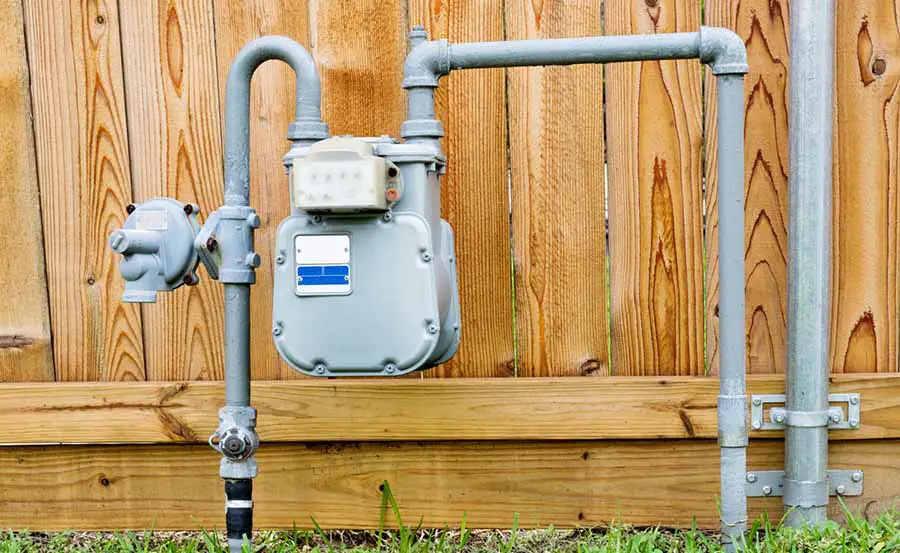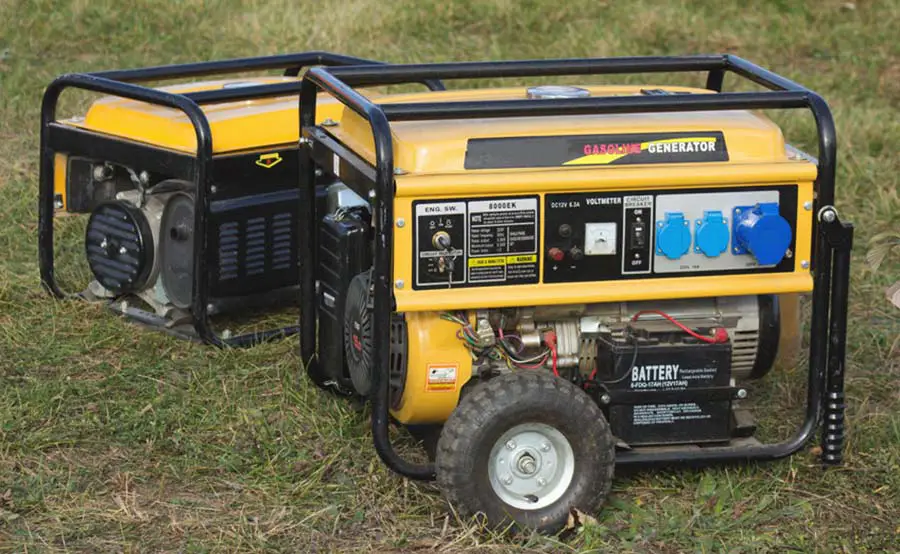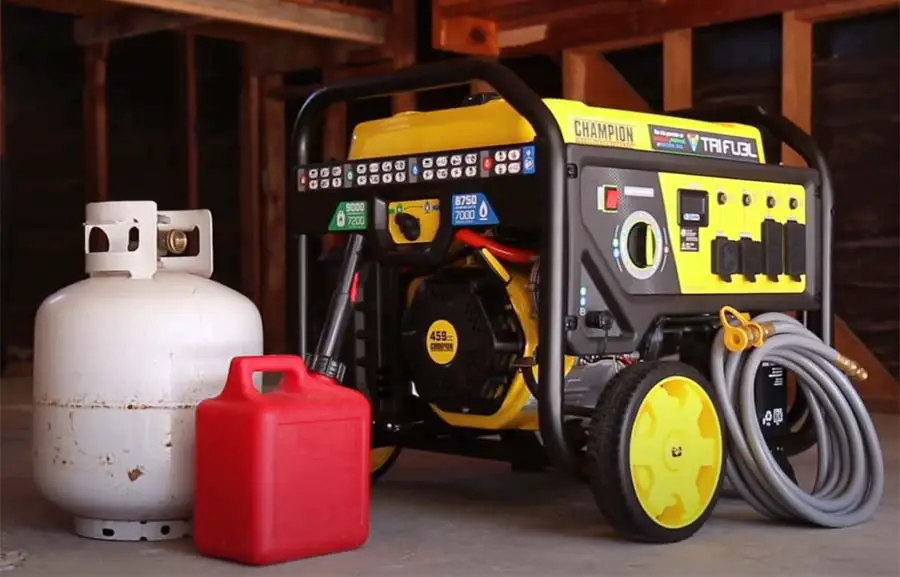
You can connect a portable generator to natural gas, but it is not always a simple matter. While some portable generators use natural gas right out of the box, others require adjustments before using natural gas as fuel.
Connecting a portable generator to a natural gas line is pretty straightforward once you’ve ensured that your generator can handle the fuel. If your generator runs on liquid fuel, such as gasoline, you’ll need to install a carburetor and conversion kit before hooking it up the natural gas mains.
There’s more to know about portable generators and natural gas. This article discusses natural gas generators and the various ways you can connect a portable generator to natural gas. It also includes tips on connecting to a natural gas source if you want to and the pros and cons of natural gas fuel for portable generators.
The Basics of Natural Gas Generators
Natural gas generators are developed to run on natural gas instead of diesel or gasoline. They account for the largest share of electricity generating capacity in the U.S.
While many natural gas generators are whole house generators, some are portable and come as huge prime power generators. These engines can be moved using big trucks, handle larger variable loads, and run for longer. And they are excellent options in areas with no utilities and where trucks must deliver natural gas.
In addition, portable generators also come in the form of continuous power generators. These can run for long periods but usually require consistent loads.
And then, we have portable generators that can be moved by hand from one place to another. Some of these generators utilize natural gas as their only source of fuel. Others can use at least two fuel sources simultaneously or individually, such as propane and natural gas, and are known as dual-fuel generators.
In addition, tri-fuel portable generators exist too. The latter can use three types of fuel to operate, depending on what is available at a given time. For such a generator, you could use natural gas, propane, or gasoline.
However, it is worth noting that portable generators dedicated to natural gas will work very differently from their dual-fuel and tri-fuel counterparts.
How Do You Hook Up a Portable Generator to Natural Gas?

How you hook up a portable generator to natural gas depends on whether it’s designed to use that fuel source or not. Below are the three strategies you can use depending on what kind of power generating engine you have available.
- Connect the portable generator to the mains
- Use a natural gas carburetor to run a generator that uses liquid fuel
- Install a natural gas conversion kit on your generator
1. Connecting a Portable Natural Gas Generator to the Mains
If you have a portable natural gas generator and natural gas in your home, connecting the engine is it is relatively easy and convenient.
First, you should consider your generator’s power capacity and compare it to the electrical appliances you want to operate. If your engine has a lower power capacity, you need to prioritize what you want to use with your portable generator.
The second step is to consult the relevant authorities in your area, such as your local power company, to determine the legal restrictions that exist concerning wiring for generators. It would be best if you consulted or hired a licensed electrician for that. Generally, a manual transfer switch is the safest option.
Third, you should install an inlet box hook-up outside your home and connect it to the panel system inside your home. Usually, the box hook-up has male connectors that stick out. Be sure to connect all the heavy-duty cables from the external receptacle to the transfer switch so that power can move from the generator to the home.
On the other hand, you should start by lubricating your generator engines and finding the correct connectors for the gas hose. If necessary, use plumbers tape to seal the connectors and prevent leakages along the gas inlet.
Once you seal the gas hose, connect it to the gas mains as you would barbecue lines and ensure the gas is delivered at a pressure ranging from 0.5 to 1.0 PSI.
You can increase or decrease the gas flow using a screwdriver to adjust the combustion gas flow mechanism. And then, you can use the multimeter to verify the generator’s output voltage and frequency.
And then, you can plug the generator’s cord into your inlet hook up by matching its holes and turning it to complete the connection. Also, plug in the generator’s attachment cable to connect it to your home and select the desired voltage.
Start the generator after switching off the utility main and on the generator main. And use the transfer switch to determine what appliances to run.
When it’s time to switch off the generator, first shut down the mains. That way, the generator can consume the remainder of the gas within it.
2. Using a Natural Gas Carburetor to Operate a Generator that Uses Liquid Fuel
If you have a portable generator that runs on liquid fuel, such as diesel, you can follow the steps above to connect it to natural gas mains and use it to run appliances in your home. However, you first need a natural gas carburetor to ensure the natural gas can work within your generator.
A carburetor is a gadget that allows the correct amount of air and fuel through its valves into the generator engine cylinders. It does so by blending the proper amount of these two things.
And through its regulation, it enables pressurized natural gas from your mains to efficiently provide fuel for your home when liquid fuel is absent. And without this gadget, you cannot convert your liquid fuel generator into one that uses the available natural gas in your home.
Typically, the carburetor is connected to the natural gas source and then connected to the generator on the other end.
3. Using a Natural Gas Conversion Kit to Operate a Portable Generator
In addition to a carburetor, you can buy and install other conversion kits to modify portable generators to use natural gas or propane, even if they originally ran on gasoline. Many of these kits will enable you to convert your engine into a tri-fuel generator.
Generally, natural gas conversion kits come with every component you need to do the conversion yourself. And many of them also work with an on-demand regulator. The component prevents the unnecessary flow of gas if your portable generator engine fails.
After that, you can use the associated hardware to connect the kit to your portable generator before joining it to a natural gas source via your mains. However, ensure you buy a compatible kit for the engine you have.
How to Bring In Natural Gas Lines for the Portable Generator
If you have natural gas in your home, connecting a portable generator will be easier. However, that depends on if you have an existing natural gas supply since only 42 percent of natural gas energy is used in residential sector end-use.
If you do not have gas mains or need to run a new gas line for outdoor use for the generator, you should prepare for several challenges. Below are some of the things you may need to do.
1. Locate Your Existing Utility Lines
You cannot run new gas lines or reroute existing ones if you have no idea where they are. So, you need to identify them and mark them. And the best way to do that is by consulting your local utility companies and hiring a professional locator instead of digging aimlessly.
Therefore, if you need to locate your utility lines, call 811. Alternatively, you can check your state 811 center website and place a request for someone to come and identify and mark your existing utility lines.
If you intend to place your generator and its associated cables and components where your utility lines exist, you need to change all your plans. For that reason, it pays to locate them first before deciding anything.
2. Pay Attention to the Rules Concerning Generators
Do not buy a generator before you learn all the rules. You may end up going at a loss if you cannot use your generator and get a refund.
For example, what do your zoning and HOA rules say about noise? The general recommendation is to avoid being exposed to over 85 A-weighted decibels of noise for prolonged periods because it causes hearing loss. However, to be on the safe side, you should aim for noise levels of 70dB or lower.
But there is one problem: most portable generators produce noises ranging from 70 to 100dB when one hears them from the standard 23 feet away. While that’s not a big issue if you live on a large lot and can move the generator farther away without bothering your neighbors, it can be challenging if you live on a smaller property.
So, you may want to consider quieter portable generators that will enable you to stay connected to your natural gas mains without breaking the noise ordinances in your locale.
Other issues worth considering are carbon monoxide poisoning and possible explosions. It’s due to these reasons why generators must stay at least 20 feet away from your home and have their engine exhausts facing away from your windows and doors. So, when you factor in the distance, you must also think about your neighbors and the dangers your generator may pose to them.
3. Think About Storage If Natural Gas Is Inaccessible In Your Area

Also, if you do not have natural gas within your locale, you have to consider putting it in a storage tank. And remember, the gas tends to be stored in the liquid form above the ground or underground, usually in huge facilities or storage tanks because of its large volume.
Therefore, you would need to think about where you would store natural gas on your property relative to existing utility lines above and below ground if you need large quantities of it for large events or a campground site, perhaps.
However, natural gas is not usually stored in tanks for home use because it is challenging to do so. That’s because they need to be stored in large spaces and under particular conditions.
So, the closest you could get is by using liquefied petroleum gases (LPG), also known as natural gas liquids. Alternatively, you could opt for methane in the form of compressed natural gas (CNG). The latter is similar to the standard natural gas in many ways. But that doesn’t mean they are the best options for portable generators.
4. Get the Necessary Permits
Putting in a new gas line or bringing natural gas into your property for the first time will likely require several permits.
For example, if you intend to install a manual transfer switch for your portable generator, you will likely have to change your existing electrical network. And that would require an electrical permit.
On the other hand, if you intend to run a new gas line for your generator, you may need to work with existing utility lines and reroute or extend them. In such cases, your plumbing or mechanical contractor may have to obtain gas or mechanical permits.
Other permits you may need include fire permits, air quality permits, and zoning permits, among others. Everything depends on where you live and what the local residential building regulations are. So, it would be best to study the guidelines concerning portable generators in your state and whether they require or are exempt from permit requirements.
5. Create a Suitable Plan
Depending on the local regulations and position of your existing utility lines, you can develop a suitable plan to guide you on the placement of your portable generator.
Considering that it is unsafe to operate generators in the rain, even if they are portable, you should think about providing adequate shelter for them. And that shelter should protect the generator from the elements while allowing an outlet for the exhaust.
Your plan should also include the correct spacing requirements for the portable generator relative to your home, your neighbors, and any other human or animal shelters in place within your property.
Therefore, consult relevant contractors and even consider hiring an architect if you cannot figure things out independently. Remember, if you do not adhere to the rules and regulations when creating your plan, you may not obtain the permits you need to operate your portable generator.
6. Professionals Are Your Friends
If you need to extend or reroute gas lines and install a transfer switch, hire professional contractors.
It is much safer for everyone all around to work with people who know what they are doing. Also, it makes it easier for you to obtain permits if you need them.
The Pros and Cons of Natural Gas for Your Portable Generator

Natural gas has its fair share of pros and some cons. Before buying a natural gas generator or converting what you have to use that fuel source, it would be best to consider all the advantages and disadvantages.
The Advantages of Natural Gas
Below are some of the pros of natural gas:
- Generally, natural gas is cleaner and better for the environment compared to other types of fossil fuels. So, if you are concerned for the environment while seeking a suitable power source, you shouldn’t feel guilty about connecting your portable generator to natural gas.
- Regarding costs, natural gas is pretty affordable. It is much cheaper than propane and both gasoline and diesel. So, in the long run, you will spend less to fuel your portable generator by connecting it to natural gas instead of using other fuel types.
- Natural gas is also available in abundance. The world has it in plenty and can supply humans for years to come.
- While natural gas is not available everywhere, there is plenty of infrastructure to store and transport it to homes and businesses. As a result, it can be transported easily with a smaller footprint.
- In addition, natural gas tends to be more reliable, especially during extreme weather events. Because it is supplied through underground lines, it is likely to be available even in emergencies.
The Disadvantages of Natural Gas
Below are some cons of natural gas.
- The most significant disadvantage of natural gas is the difficulty people face in storing it within residential properties. It requires specific conditions that may be challenging to achieve in smaller settings. And one of them is its more significant volume which requires much more space than fuels like gasoline.
- It is also worth noting that natural gas is not a sustainable fuel. While it is available in abundance right now, humans cannot recycle and reuse it.
- Also, natural gas has a long manufacturing process which is quite costly.
- Additionally, natural gas is combustible. If you mishandle when connecting and using your portable generator, it may explode.
- When natural gas burns poorly, it tends to produce carbon monoxide. And that can cause carbon monoxide poisoning, which may be fatal.
Final Thoughts
Natural gas can cause carbon monoxide poisoning or explosions when mismanaged and can pose challenges regarding its storage. Also, it may force you to spend a significant sum upfront in your quest to run new gas lines. However, once you’ve done the work and you have access to the gas for your portable generator, it will save you money in the long run. And it is safe when handled correctly.
In addition, it will provide a continuous source of fuel, available even during emergencies. Also, you will produce fewer emissions, thus reducing your negative impact on the environment. For these reasons, it would be best to modify and connect your existing portable generator to natural gas if you can. Alternatively, you can buy a natural gas generator and use it straight away.
